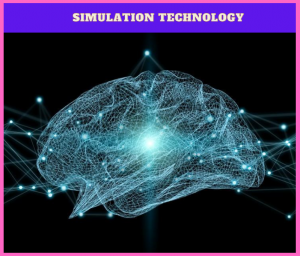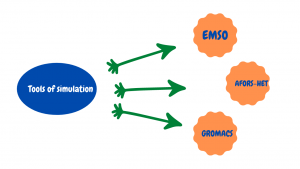Simulation
What is simulation?
Simulation seems to be the re-creation, in a controlled situation, of a real-world situation process. It uses a system called modeling to comprehend the simulation outcome. A diagram or model is a description of even an object or process which helps to explain that phenomena if it is not experienced personally. We come up with a lot of rules and regulations in evidence to understand the universe, and those models combined allow us to construct simulations. For instance, when there is a surrounding source of heat, we could research how charged particles move, and build a model to explain it. Instead, we can bring together hundreds of molecules, and model them. You’ll normally need to enter all sorts of complex mechanics equations for practical simulations on a computer. Computers can do simulations by using these equations much smarter than people, and in recent times have enabled us to bring simulations to a new phase.

Figure 1. Simulation technology
How are the simulations used?
Simulation modeling addresses real-world issues in a secure and practical manner. It offers an essential analytics approach that is easily checked, conveyed, and acknowledged. Simulation modeling offers useful opportunities across industries globally, by offering simple insights into complex structures. Bits that are not atoms. Simulation permits testing on a framework ‘s true graphical signal. Unlike structural analysis, including creating a replica of a structure on a dimension, simulation is computer-based, using algorithms and formulas. Simulation software offers a complex environment in which computer models can be studied while operating, along with the potential to display these in 2D or 3D. Simulation applications in industry are diverse, and it is frequently used when performing experiments on even an actual world is difficult or impractical, frequently related to funding or time. The ability to analyze the experiment as it operates sets modeling simulation apart from the other approaches, including those utilizing a Spread or layer of cells. Both comprehension and confidence are easily built up by being able to observe procedures and communicate with a simulation model in practice.
The role in the education field.
Simulation techniques provide many benefits in contrast with conventional teaching techniques. We will explain complex ideas, encourage users to interact with virtual machinery, as well as provide users with reviews that will help users to develop knowledge and skills. Deep-term those which are often cost-effective. Simulation tools can turn abstract concepts into engaging visual content, making the output and interaction between various parts of the system easier for students. You will learn to know the equipment and community and exercise the requisite skills without causing injury to themselves, the facilities, and the environment. Participants are available to participate in a wide range of situations, including such emergency situations, and they can execute the correct protocols because such events happen in the real world. Using simulation devices, students are able to strengthen theoretical awareness with hands-on experience, providing a deeper understanding of the subject. Simulation software can track student progress and provide structured input which can assist in skill growth. Teachers can also provide tailored learning skills students can select that skills to build on particular training tools and obtain them, and instructors can also monitor the information. Learning materials are easily upgraded, created, or changed, and learning can be done whatever the period or location. The right to obtain physical fitness equipment isn’t any more an issue because it is still open to digital equipment.
The role of simulation in the Engineering field.
Company simulations provide an open experience wherein marketing strategies and market opportunities could be tested avoiding value proposition expenses and uncertainty. For both consumer relationships and business systems, challenging consumers and growing market dynamics may be exploited to manage the activity. Participants were becoming acquainted with global legislation covering domestic and foreign market practices. Also, such famous video games as the NFL Madden by EA Sport introduce a business aspect into the game ‘s administration section. Players no longer restricted to primarily perfecting their abilities as a former athlete, but may also experimenting with expertise in sports marketing.
The best tools for simulation and modeling.
The first query is: What are you simulating definitely? There are literally dozens of programs over there to simulate any and every particular purpose. Others are more common, and also very versatile, but to adjust themselves to specific needs you have to write others code. Others have already been committed to some use. Instead, you need just (and could only) define those criteria to get a response. Less versatile in exchange but so much easier.

Figure 2. Tools of simulation technology
- AFORS-HET:
This tool can be used for Solar Cells and Calculating computer models. This includes simulation of a random 1D series of semi-conductive layers and connectors, steady-state, steady-state, tiny frequency domain perturbation and specific temporary TR calculation phase, arbitrarily defined variations of variables and configuration of parameters, Simulation of inner cell variables: group diagram, cellular phone interactions, replication, phase changes.
- GROMACS:
As a simulation kit for biomolecular structures, GROMACS creates objects using the Newtonian differential equation. Forces control mobility: for example, two positive ions neutralize one another. Manipulating troops is by far the most economical option of the modeling since all pairs of molecules will theoretically come into contact, and simulations require several particles. GROMACS offers flexibility to compensate for a broad variety of different forms of force measurements.
- EMSO:
EMSO is an entire system that allows users to easily perform numerical modeling, simulation, and automation. It is produced entirely in C++. Mainly available for Microsoft and Ubuntu (Linux) software applications, though it can be optimized for many other systems as well.
The future of the technology.
Should you imagine while planning, too? If you ever do simulation, maybe at the start, midway into your model, or at the extreme end when all is still finished and it may be too late to alter even the tiniest changes? As per the Business Advantage research group “2016 Global CAD Trends,” 55 percent of project users are conscious of simulation but just 34 percent use simulations in their projects. Simulation, nevertheless, is rated 4th out from the 15 most significant CAD patterns, the report says. To learn why simulations are important, we spoke on the present and future condition of simulation with several simulations experts. The simulation market is developing in various directions, integrating new technologies and making predictions, using artificial intelligence and machine learning, reducing barriers to the adoption and simplicity of use, and increasing its appeal through partnership and accessing data to broader audiences within an enterprise. A major trend in simulation and an AutoCAD focus is an amazing race to any and all sizes of businesses. Price was also an important inhibitor of wider adoption, whether it be in the type of software, hardware or repair activities. Cloud-based streaming services frequently benefit from being reinterpreted throughout their growth and often prioritize user-friendliness as the main target. Such strategies more typically tackle the cost concerns of upfront customer offers, the expense of hardware maintenance, and efficiently offer scalable, on-demand computing services.